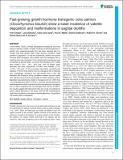Files in this item
Fast-growing growth hormone transgenic coho salmon (Oncorhynchus kisutch) show a lower incidence of vaterite deposition and malformations in sagittal otoliths
Item metadata
| dc.contributor.author | Chalan, Irvin | |
| dc.contributor.author | Solsona, Laia | |
| dc.contributor.author | Coll-Lladó, Clara | |
| dc.contributor.author | Webb, Paul B. | |
| dc.contributor.author | Sakhrani, Dionne | |
| dc.contributor.author | Devlin, Robert H. | |
| dc.contributor.author | de la Serrana, Daniel Garcia | |
| dc.date.accessioned | 2022-10-12T14:30:16Z | |
| dc.date.available | 2022-10-12T14:30:16Z | |
| dc.date.issued | 2022-10-10 | |
| dc.identifier | 281179925 | |
| dc.identifier | 6adf22aa-3271-4338-ab2f-7e07c064c40a | |
| dc.identifier | 85139571970 | |
| dc.identifier.citation | Chalan , I , Solsona , L , Coll-Lladó , C , Webb , P B , Sakhrani , D , Devlin , R H & de la Serrana , D G 2022 , ' Fast-growing growth hormone transgenic coho salmon ( Oncorhynchus kisutch) show a lower incidence of vaterite deposition and malformations in sagittal otoliths ' , Journal of Experimental Biology , vol. 225 , no. 19 , jeb244099 . https://doi.org/10.1242/jeb.244099 | en |
| dc.identifier.issn | 0022-0949 | |
| dc.identifier.other | Jisc: 578630 | |
| dc.identifier.other | ORCID: /0000-0003-2532-344X/work/120849664 | |
| dc.identifier.uri | https://hdl.handle.net/10023/26184 | |
| dc.description | DGS is a Serra Húnter Tenure-Track lecturer, and this work has been partially funded by the Ministerio de Ciencia y Tecnología grant number RTI2018-100757-B-100. RHD acknowledges support from the Canadian Regulatory System for Biotechnology (grant number 61740). | en |
| dc.description.abstract | In fish otoliths, CaCO3 normally precipitates as aragonite, and more rarely as vaterite or calcite. A higher incidence of vaterite deposition in otoliths from aquaculture-reared fish has been reported and it is thought that high growth rates under farming conditions might promote its deposition. To test this hypothesis, otoliths from growth hormone (GH) transgenic coho salmon (TF) and non-transgenic (NT) fish of matching size were compared. Once morphometric parameters were normalized by animal length, we found that TF fish otoliths were smaller (-24%, -19%, -20% and -30%; P<0.001 for length, width, perimeter and area, respectively) and rounder (-12%, +13.5%, +15% and -15.5% in circularity, form factor, roundness and ellipticity; P<0.001) than otoliths from non-transgenic fish of matching size. Interestingly, transgenic fish had smaller eyes (-30% eye diameter) and showed a strong correlation between eye and otolith size. We also found that the percentage of otoliths showing vaterite deposition was significantly smaller in transgenic fish (21-28%) compared to non-transgenic (69%; P<0.001). Likewise, the area affected with vaterite deposition within individual otoliths was reduced in transgenic fish (21-26%) compared to non-transgenic (42.5%; P<0.001). Our results suggest that high growth rates per se are not sufficient to cause vaterite deposition in all cases, and that GH overexpression might have a protective role against vaterite deposition, an hypothesis that needs further investigation. | |
| dc.format.extent | 2310569 | |
| dc.language.iso | eng | |
| dc.relation.ispartof | Journal of Experimental Biology | en |
| dc.subject | Otolith | en |
| dc.subject | Salmon | en |
| dc.subject | Transgenic | en |
| dc.subject | Vaterite | en |
| dc.subject | GC Oceanography | en |
| dc.subject | NDAS | en |
| dc.subject.lcc | GC | en |
| dc.title | Fast-growing growth hormone transgenic coho salmon (Oncorhynchus kisutch) show a lower incidence of vaterite deposition and malformations in sagittal otoliths | en |
| dc.type | Journal article | en |
| dc.contributor.institution | University of St Andrews. School of Chemistry | en |
| dc.identifier.doi | 10.1242/jeb.244099 | |
| dc.description.status | Peer reviewed | en |
This item appears in the following Collection(s)
Items in the St Andrews Research Repository are protected by copyright, with all rights reserved, unless otherwise indicated.

